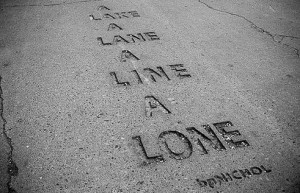In starting to read the texts for this course, I was struck by how much modern poetry, literature and word art is concerned with the dynamic between orality and textuality that we are learning about.
bpNicol’s poetry often plays on the discontinuities between writing as text and spoken language as sound. He was a Vancouver, BC born poet and UBC graduate (teaching certificate, 1963) whose works, among those of like-minded others, revolutionized Canadian writing in the 1960’s and 1970’s.
The above is a photo of an eight-line poem by bpNichol that is carved into a lane-way pavement behind the Coachhouse Press on the U of T campus, making a pun on it’s being a literal example of concrete poetry engraved into the street cement.
Poetry has always had a musical connection to song, and as such, it has its own system of rules for making poems fit certain musical patterns (prosody) that are different from ordinary speech. Poetry also has a dimension of sense to it, which is the statement or meaning that it makes, or the image that it suggests.
bpNicol’s work shows us that poetry written on the page, or scroll, or stone tablet has had from ancient times a certain look or form to it—a shapeliness, like that of an object—that distinguishes it from other forms of writing. Poetry activates sound, sense, and shape, all at the same time. For this reason, I thought that this poem and image would make a good jumping off point into the course.
About me
My name is Oren Lupo, and I’m a program coordinator in Continuing Studies at Langara College in Vancouver, BC. My areas of professional responsibility include business management and self-employment programs.
Before joining the College in 2005, I worked as an instructor in the department of English at the University of Toronto for a number of years. I taught mainly undergraduate survey courses in literature, the modern novel, and effective writing.
After moving to Vancouver in 2000, I worked as a writer, content editor and web designer for a number of start-up software and dot.com companies (RIP).
This is my ninth course in the MET program, and I am still getting the hang of being an online course participant. The main reason I chose the MET program was that it presents the opportunity to experience distance learning first-hand, while at the same time it provides a diverse education in the theories and cultures of online learning. I’m a big believer in the idea that how one learns–the context and environment–shapes to a great extent what one learns, how it is remembered, and how it fits into a meaningful pattern.



